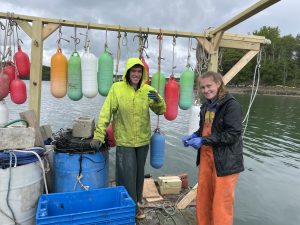
Research Spotlight: Maine’s Emerging Scallop Aquaculture Sector Reinforced by Brady Lab Ph.D. Student Research
This summer, University of Maine Ph.D. student Chris Noren leads the third year of Atlantic sea scallop data collection in Damian Brady’s lab, an affiliate faculty member of the Aquaculture Research Institute. The wild scallop catch was valued at $488 million in 2020, rivaling lobster ($563 million) and exceeding salmon ($478 million). The rise of domestic & sustainable seafood as an increasingly desirable and necessary product, naturally compels the scallop industry to develop farmed counterparts as efficiently as possible. Until then, the supply-demand gap increases, leading the Brady Lab to develop sustainable industry practices for an emerging US aquaculture subsector, beginning with culture methods.
Lantern nets are the US industry standard, at least for suspended culture. They boast some advantages to bottom culture, namely a faster growth rate. Still, lantern nets have their limitations. Farming shellfish is backbreaking labor, with biofouling, sediment, and gear itself contributing to a weight hovering around 300 lbs. Most days, you can see the process in action, with Noren and his interns Ruth Havener and Gary Moline going between the experimental farm and the processing station on their floating dock (affectionately named Norman). Their routine is a good reminder of why a collaborative team makes all the difference.
During the off-season, Havener studies at Duke University. However, she comes from a Maine family with multigenerational ties to the lobster industry. Life on the water has always been a cornerstone for her, but she did not realize her passion for Maine aquaculture until she meditated on life outside of the state. Aside from asserting “scallops are the best-tasting seafood,” Havener values their intersection with eDNA research. “I’m doing this internship to learn more about the aquaculture industry and its practices so I can apply it to my future career.” When Moline is away from his marine biology program at the University of Maine, he calls Belfast home. What began as a recreational diving trip in Mexico bloomed into “a whole new world” of possibility. Hands-on experience solidified his pathway during his time in ARI’s Aquatic Animal Health course. Each has a unique aquaculture background, but both Ruth and Gary ultimately share the desire to stay connected to the water.

“It’s work for sure, but it doesn’t feel like it,” according to Moline. Sustained progress on critical work requires a passionate cohort. Through their joint efforts, we can better understand why innovative research is crucial throughout aquaculture, with scallops as no exception. Noren is taking additional initiative by looking into site optimization and different culture methods using innovative gear. Coupled with unique, strategic technology will solidify upward mobility of the state’s industry.
Noren’s bifurcated interests relate to gear innovation and temperature oscillation. Workability and efficiency are necessary considerations for scallop aquaculture, and lantern nets somewhat contradict the true capacity of suspended culture. Noren looks to contemporary Japanese farms, which serve as a gold standard for scallop operations. Japan employs an innovative growout alternative: ear-hanging. The name paints a unique visual of how the system works; nets on a longline are replaced by suspended ropes with scallops spaced a few inches apart and secured by a pin positioned by their notch. Decades of implementation abroad indicates this system works well, with reduced biofouling, making the lines easier to handle. This alone contributes to residual benefits, especially in terms of processing and maintenance. Understanding impacts of a scallop farm’s location is of equal importance when it comes to optimizing the sector. The secret to effective site selection is intrinsically tied to the second aspect of Noren’s research: growth implications of oscillating temperature.
Both research foci rely on several tools and key players across the state. Researchers at the Darling Marine Center reference parameters (chlorophyll, temperature, pH, and salinity) provided by the Land/Ocean Biogeochemical Observatory (LOBO) Buoy, maintained by the Brady Lab. Concurrently, commercial growers from Vertical Bay Farm (Penobscot Bay) and Acadia Aqua Farm (Frenchman Bay) have been invaluable assets, offering high-value study sites that may be otherwise inaccessible to Noren and his peers. “We get to research under real conditions,” he notes. The team will “often run small trials at our farm and then scale them to commercial farms to get a better understanding of their relevance. Growers are better able to assess whether our research would work at scale. So, we get real world results and the industry gets to alleviate some risk from being an early adopter of new research.”Research like Noren’s, alongside his mentorship for Havener and Moline, is crucial for Maine’s blue economy as it continues to accelerate. While industry leaders and researchers in the sector are the primary demographic for his work, his reach extends far beyond that. Producing informed and passionate externs is a crucial step in moving the industry forward as well. Their curiosity is contagious, and the impact from their knowledge can be limitless. Like the tide, scallop research moves fast. Keep up with groundbreaking findings in Chris’ upcoming paper: How scallop growth oscillates with temperature and season for sustainable development of the scallop aquaculture sector.

